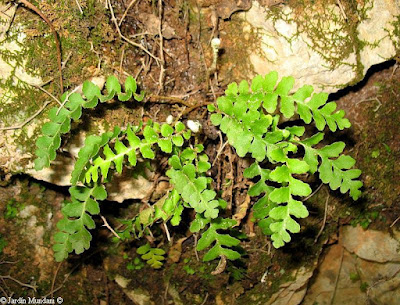His diploid ancestor Asplenium javorkeanum, synonymous with Ceterach officinarum ssp. bivalens or Asplenium ceterach ssp. bivalens, remained confined for millions of years in the Balkan countries, east of the Italian peninsula, Sicily and Turkey. Preferably living on acid soils in high places facing the north or northwest.
Family Tree of Asplenium javorkeanum and his son Asplenium ceterach with the shape of their fronds. Drawing taken from the excellent article "Phylogenetic analysis of Asplenium subgenus Ceterach (Pteridophyta: Aspleniaceae) based on plastid and nuclear ribosomal DNA ITS sequences.". http://www.amjbot.org/cgi/content/full/90/3/481
Family Tree of Asplenium javorkeanum and his son Asplenium ceterach with the shape of their fronds. Drawing taken from the excellent article "Phylogenetic analysis of Asplenium subgenus Ceterach (Pteridophyta: Aspleniaceae) based on plastid and nuclear ribosomal DNA ITS sequences.". http://www.amjbot.org/cgi/content/full/90/3/481
Millions of years ago there was a mutation in the meiosis of a sporangium of Asplenium javorkeanum and instead of a meiosis to halve the number of chromosomes of the spores, which are normally haploid, there was a simple mitosis (this mutation gets apomeiosis name, the absence of meiosis and is relatively common in ferns), resulting in diploid spores, diplosporas perfectly viable, which led to germinate to diploid gametophytes, which produce diploid gametes and, after fertilization, was born a new species with double chromosome, which in genetics called tetraploidy.
The new species, Ceterach officinarum ssp. officinarum, synonymous Asplenium ceterach ssp. ceterach, called Doradilla in Spain, has at its core two identical genomes, so it is autotetraploid.
Ceterach officinarum ssp. officinarum between the stones of a wall patch, about 100 meters, in the town of Soller on the island of Mallorca. Sharing the same substrate can see a sheet of Ophrys fusca and mossy fern Selaginella denticulata.
This tetraploidy allowed to leave their ancestral habitat and conquer new lands, to confer greater resistance to drought, sun exposure and limestone soil alkalinity, can live in many different habitats and soils, from sea level to the mountain peaks, reaching its expansion in the Canary Islands to the west, the Middle East to the East, Germany, Benelux and the British Isles to the north and the Mediterranean coast of Africa to South.
This tetraploidy allowed to leave their ancestral habitat and conquer new lands, to confer greater resistance to drought, sun exposure and limestone soil alkalinity, can live in many different habitats and soils, from sea level to the mountain peaks, reaching its expansion in the Canary Islands to the west, the Middle East to the East, Germany, Benelux and the British Isles to the north and the Mediterranean coast of Africa to South.
"Doradilla" growing on limestone rocks north-facing about 600 meters, in the village of Benaocaz in Cadiz, in the Natural Park Sierra de Grazalema.
The fronds of the doradilla have a length ranging between 3 and 20 cm, the petiole is brown-black and much smaller than the blade, which is lanceolate or ovate-lanceolate, with the beam of a green color varies greatly habitat, from bright green to dark green and dull, even with bluish-gray tinge. The underside is covered with paleas shiny, silvery iron. The sori are oblong-linear with or without a rudimentary indusium. The pinnae are alternate, 6 to 15 pairs, ovate or oblong with rounded apex and entire or crenate edge.
The fronds of the doradilla have a length ranging between 3 and 20 cm, the petiole is brown-black and much smaller than the blade, which is lanceolate or ovate-lanceolate, with the beam of a green color varies greatly habitat, from bright green to dark green and dull, even with bluish-gray tinge. The underside is covered with paleas shiny, silvery iron. The sori are oblong-linear with or without a rudimentary indusium. The pinnae are alternate, 6 to 15 pairs, ovate or oblong with rounded apex and entire or crenate edge.
Doradilla with long fronds about 20 cm. farther apart with pinnae, petiole edge slightly crenate and long-colored, living in the same habitat with other specimens of normal appearance in the wonderful public property of Planicia, located in the municipality of Banyalbufar in Mallorca Island.
Obverse of a typical sheet of Ceterach officinarum ssp. officinarum.
Underside of a sheet with paleaceous hairs and conspicuous sori, formed by sporangia like dark balls, which are about to disperse the spores.
Details of previous sori with conspicuous dark sporangia.
Microscopic structure of a paleaceous scale, which consists of the carcasses of dead cells, dry and empty in the form of honeycomb.
Spores contained in sporangia transparent bag, waiting to be deployed as a small catapult and disperse as far as possible.
Ceterach officinarum sporangia after spore dispersal. Ring cells acted as a spring bent at the ends that the release of displays with unusual force, tearing the bag containing the spores and dispersed.
In this micrograph one can see the structure of a sporangium in full, with the sporangiophore to the left that serves as the umbilical cord and feeds the sporangium, the bag ripped and empty uterus and acts as a feeding ring spores as placenta and then deployed and dispersed.
And finally the very large spores of ferns typical tetraploid. His ancestor diploid Asplenium javorkeanum has much smaller spores, which never exceed the 39 microns.














No comments:
Post a Comment